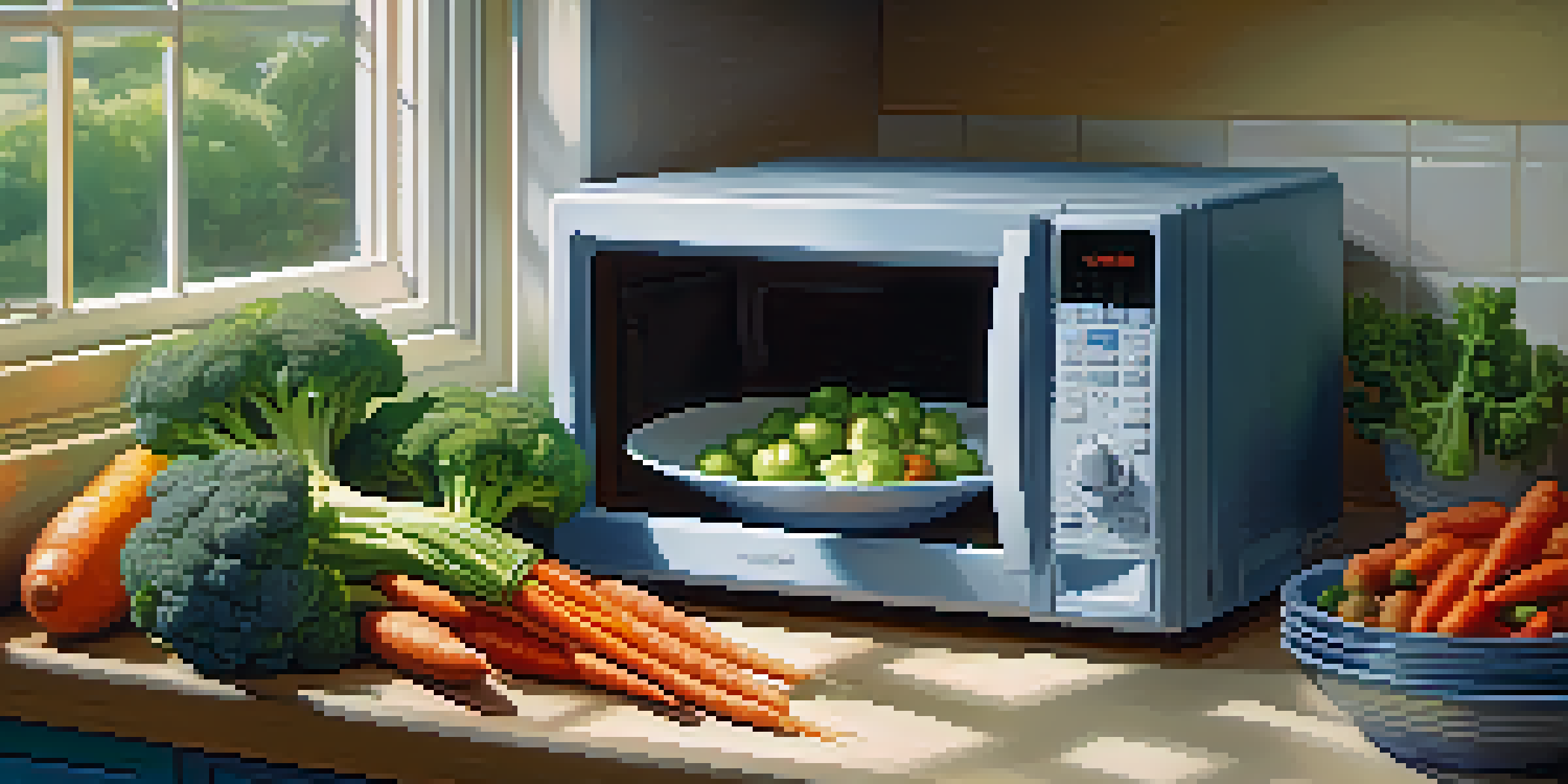Microwaving: Quick Health Tips for Nutritious Cooking

Understanding the Basics of Microwaving
Microwaving is a convenient cooking method that uses electromagnetic waves to heat food. Unlike traditional cooking, which relies on direct heat, microwaves excite water molecules, leading to faster cooking times. This method can be particularly beneficial for busy lifestyles, allowing you to prepare meals quickly without sacrificing nutrition.
Cooking is like love. It should be entered into with abandon or not at all.
One of the key advantages of microwaving is that it often preserves the nutrients in food better than other cooking methods. For instance, steaming vegetables in the microwave can retain more vitamins compared to boiling them, where nutrients leach into the water. By understanding how microwaving works, you can make informed choices about your cooking.
Despite its speed, it's important to remember that not all foods are suitable for microwaving. Some items can become rubbery or overcooked if not monitored closely. So, having a solid grasp of microwave cooking techniques can help you maximize flavor and texture while ensuring your meals are still healthy.
Choosing the Right Containers for Microwaving
Selecting the appropriate containers is crucial for safe and effective microwaving. Glass, ceramic, and certain plastics labeled 'microwave-safe' are ideal choices, as they can withstand the heat without leaching harmful chemicals. Avoid using metal containers, as they can cause sparks and damage both your microwave and your food.

When using plastic, check for BPA-free labels to ensure that no harmful substances will contaminate your food. Additionally, be mindful of the container's size; overcrowding can lead to uneven cooking, while too little food can result in overheating. Choosing the right container not only enhances cooking but also contributes to your overall health.
Microwaving Preserves Nutrients
Using the microwave to steam vegetables retains more vitamins compared to boiling, making it a healthier cooking option.
Remember to use covers when microwaving to trap steam and promote even cooking. However, ensure that these covers are also microwave-safe to avoid melting or releasing toxins. By taking this simple step, you can elevate your microwaving experience and keep your meals nutritious.
Steaming Vegetables for Maximum Nutrients
One of the best ways to utilize your microwave is by steaming vegetables, which helps retain their nutrients. Simply place washed vegetables in a microwave-safe bowl with a bit of water, cover them, and cook for a few minutes. This method allows for quick cooking while keeping the vibrant colors and flavors intact.
The microwave is a wonderful tool for cooking, but it should be used with care to ensure food safety and quality.
For example, broccoli and carrots can be steamed in just a few minutes, providing a healthy side dish rich in vitamins. The key is to avoid overcooking; a little crunch can indicate that they are still packed with nutrients. Experiment with different vegetables and cooking times to find what works best for you.
Additionally, consider seasoning your steamed vegetables with herbs or a splash of lemon juice post-cooking. This not only enhances flavor but also makes your meal more enjoyable. By incorporating steamed veggies into your diet, you'll nourish your body without the need for elaborate cooking methods.
Microwave Cooking Proteins Safely
Cooking proteins in the microwave can be quick and efficient, but safety is paramount. Ensure that meats, poultry, and fish reach appropriate internal temperatures to prevent foodborne illnesses. Using a food thermometer can take the guesswork out of cooking, ensuring that your proteins are both safe and delicious.
For best results, cut larger pieces of meat into smaller portions to promote even cooking. Covering your protein with a microwave-safe lid or wrap helps retain moisture and flavor. This simple technique can keep your meals tender and juicy, making for a more enjoyable dining experience.
Choose Safe Microwave Containers
Selecting microwave-safe containers, like glass or BPA-free plastics, is essential to avoid harmful chemicals and ensure even cooking.
Don't forget to let your proteins rest for a minute after microwaving; this allows the heat to distribute evenly. By practicing these tips, you'll be able to microwave proteins quickly without compromising on safety or taste.
Microwaving Grains: Fast and Nutritious Options
Grains like rice, quinoa, and oats can be easily prepared in the microwave, saving you time while still delivering nutrition. For example, a bowl of oatmeal can be ready in under five minutes, providing a hearty breakfast packed with fiber. Just add water or milk, toss in your favorite toppings, and you’re good to go!
When cooking rice or quinoa, use a microwave-safe container with a lid to prevent spills and ensure even cooking. The steam generated inside will help the grains cook perfectly. This method not only speeds up the process but also reduces the need for constant monitoring like traditional stovetop methods.
Consider experimenting with different grains to diversify your meals. Whole grains provide essential nutrients and can be a great base for a variety of dishes. Microwaving grains opens up a world of quick and nutritious meal options for busy individuals.
Flavoring Your Meals without Extra Calories
One of the challenges with microwaving is maintaining flavor without piling on extra calories. Instead of heavy sauces, try using herbs, spices, and citrus to enhance the taste of your dishes. A sprinkle of garlic powder or a squeeze of lemon can elevate a simple steamed vegetable dish and make it more enticing.
Additionally, adding a drizzle of olive oil or a dash of balsamic vinegar post-cooking can provide a flavor boost without adding excessive calories. These small changes can transform your meals while keeping them healthy and satisfying. Don't hesitate to get creative with flavor combinations!
Flavor Without Extra Calories
Enhancing meals with herbs, spices, and citrus can elevate flavor without adding excess calories, making microwaved dishes more enjoyable.
Experimenting with different seasonings can also prevent meal monotony. Trying international spices can introduce new flavors, making your microwaved meals exciting. With the right flavoring techniques, you can enjoy delicious meals that align with your health goals.
Microwaving Leftovers: A Healthy Approach
Microwaving is an excellent way to reheat leftovers, making it a practical choice for busy lifestyles. However, it’s essential to do this correctly to maintain the nutritional value and flavor of your meals. Cover your leftovers to keep moisture in and prevent drying out, which can often happen with microwave reheating.
When reheating, remember to stir or rotate your food midway through to ensure even heating. This helps avoid cold spots where bacteria could survive. A quick check with a food thermometer can also assure you that your leftovers are safe to eat.

By reheating leftovers in the microwave, you can save time and reduce food waste. This approach not only helps in meal prep but also supports healthier eating habits. With these tips, you can enjoy your leftovers without compromising on health or taste.